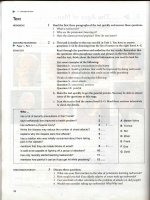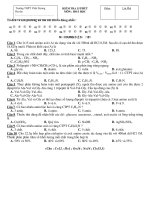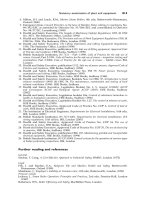Astm e 1037 15
Bạn đang xem bản rút gọn của tài liệu. Xem và tải ngay bản đầy đủ của tài liệu tại đây (87.06 KB, 2 trang )
Designation: E1037 − 15
Standard Test Method for
Measuring Particle Size Distribution of RDF-51
This standard is issued under the fixed designation E1037; the number immediately following the designation indicates the year of
original adoption or, in the case of revision, the year of last revision. A number in parentheses indicates the year of last reapproval. A
superscript epsilon (´) indicates an editorial change since the last revision or reapproval.
technique itself. However, hand measurement is more timeconsuming than sieving techniques.
1. Scope
1.1 This test method is used to determine the size distribution of a RDF-5 sample. Size is defined as the maximum length
of the particle, where length is determined by the RDF-5
manufacturing process. That is, a pellet, cubette, or briquette
all have a recognizable length. Fig. 1 displays the sizes and
shapes of some RDF-5 particles.
4. Apparatus
4.1 Labelled Containers, used to hold the particles which
are separated by size. Appropriate containers are beakers or
pans labelled “≥70 mm”, “≥60 mm − <70 mm”, etc. The tare
weight of each container shall be recorded to 0.1 g.
1.2 An air dried RDF-5 sample is separated into categories
of differing particle sizes. The size distribution is measured as
the weight percentage of each size category. A graph of a
function of the cumulative fraction of material by weight finer
than particle size versus particle size is plotted. From this plot
are taken values which describe the size distribution—the
uniformity constant and the characteristic particle size.
1.3 This standard does not purport to address all of the
safety concerns, if any, associated with its use. It is the
responsibility of the user of this standard to establish appropriate safety and health practices and determine the applicability of regulatory limitations prior to use.
4.2 Scale, capable of weighing the sample and container
with an accuracy of 0.1 g.
4.3 Vernier Calipers, a length-measuring instrument having
an accuracy of 0.1 mm.
5. Procedure
5.1 The sample shall weigh 1.0 6 0.1 kg (2.2 6 0.2 lb)
unless otherwise specified. Record the weight of the sample to
the nearest 0.1 g.
5.2 Beginning with the largest particles, measure the length
of each particle in the sample. Separate the particles into
containers labelled as the size categories of less than 10 mm,
10 to less than 20 mm, 20 to less than 30 mm, 30 to less than
40 mm, etc. as needed.
2. Terminology
2.1 Definitions:
2.1.1 RDF-5—solid fuel derived from municipal solid waste
in which the processed combustible fraction is densified
(compressed) into the form of pellets, cubettes or briquettes.
5.3 Record the weight of each size category to 0.1 g.
5.4 Add the weights of the size components. If this sum
differs by more than 2 % from the sample weight recorded
initially, then reject the analysis and begin another test.
3. Significance and Use
5.5 Use the sum of the separate size categories as the total
weight to determine weight percentages of each size fraction. If
the weight percentage of any fraction is greater than or equal to
25 %, then separate that fraction into two portions of 5-mm
size categories. Continue separating the size fraction into
categories of 2.5 mm, 1.25 mm, etc., until the weight percentage of each fraction is less than 25 %.
3.1 The particle size distribution of RDF-5 strongly influences the storage and handling characteristics of the fuel. Small
particles tend to block flow through storage bins and feed
hoppers, although correct bin and hopper designs will alleviate
this problem of blockage.
3.2 This test method of measuring size manually allows
accurate description of RDF-5 particle size distribution.
Manual measurement is superior to sieving techniques,
wherein particles may be broken by the size separation
6. Calculation
6.1 With each particle size for which there is data, calculate
y, the cumulative fraction of the sample less than that particle
size. This is found by summing the weight percentages of all
fractions less than that size. Also calculate the value of the
Rosin-Rammler function for each particle size, as follows:
1
This test method is under the jurisdiction of ASTM Committee D34 on Waste
Management and is the direct responsibility of Subcommittee D34.03 on Treatment,
Recovery and Reuse.
Current edition approved Sept. 1, 2015. Published September 2015 Originally
approved in 1984. Last previous edition approved in 2009 as E1037 – 84 (2009).
DOI: 10.1520/E1037-15.
ln
Copyright © ASTM International, 100 Barr Harbor Drive, PO Box C700, West Conshohocken, PA 19428-2959. United States
1
S
1
12y
D
(1)
E1037 − 15
FIG. 2 Size Distribution Example—Test Number 1
7. Report
7.1 Report the uniformity constant, n (a dimensionless
number), and the characteristic particle, x0 (millimeters).
FIG. 1 RDF-5 Sizes
8. Precision
6.2 Plot ln[1/(1 − y)] versus particle size on log-log paper.
Data points will yield a straight line.
8.1 Table 1 presents the results of intra- and inter-laboratory
precision testing. Intra-laboratory and inter-laboratory tests
were performed on different populations of RDF-5.
6.3 Determine two values which characterize this line—the
uniformity constant and the characteristic particle size. The
uniformity constant, n, is defined as the slope of the line. The
characteristic particle size, x0, is defined as the size at which
63.2 % of the particles (by weight) are smaller. The characteristic particle size is the size corresponding to ln[1/
(1 − y)] = 1.0. Fig. 2 is an example of this plot.
TABLE 1 Results of Precision Testing
Intra-laboratory
Inter-laboratory
Sample mean
Standard deviation
Sample mean
Standard deviation
Uniformity
Constant
Characteristic
Size
2.42
0.16
2.65
0.18
3g
2 mm
36 mm
2 mm
ASTM International takes no position respecting the validity of any patent rights asserted in connection with any item mentioned
in this standard. Users of this standard are expressly advised that determination of the validity of any such patent rights, and the risk
of infringement of such rights, are entirely their own responsibility.
This standard is subject to revision at any time by the responsible technical committee and must be reviewed every five years and
if not revised, either reapproved or withdrawn. Your comments are invited either for revision of this standard or for additional standards
and should be addressed to ASTM International Headquarters. Your comments will receive careful consideration at a meeting of the
responsible technical committee, which you may attend. If you feel that your comments have not received a fair hearing you should
make your views known to the ASTM Committee on Standards, at the address shown below.
This standard is copyrighted by ASTM International, 100 Barr Harbor Drive, PO Box C700, West Conshohocken, PA 19428-2959,
United States. Individual reprints (single or multiple copies) of this standard may be obtained by contacting ASTM at the above
address or at 610-832-9585 (phone), 610-832-9555 (fax), or (e-mail); or through the ASTM website
(www.astm.org). Permission rights to photocopy the standard may also be secured from the Copyright Clearance Center, 222
Rosewood Drive, Danvers, MA 01923, Tel: (978) 646-2600; />
2









